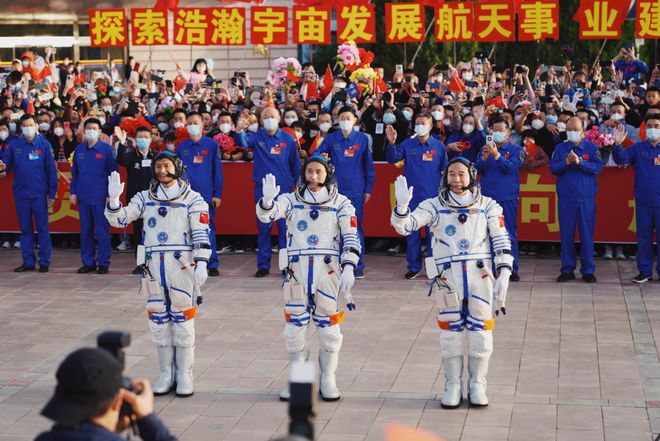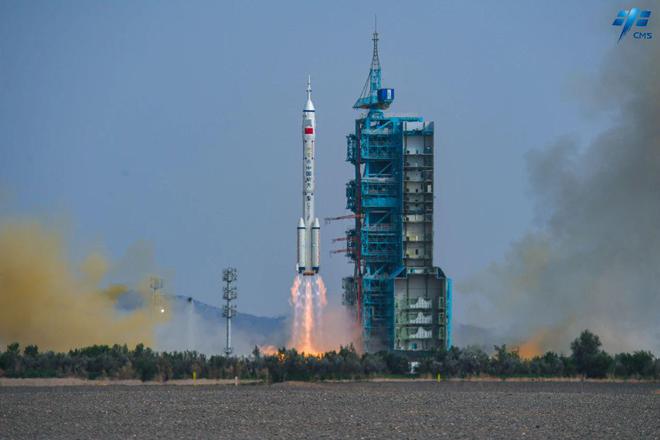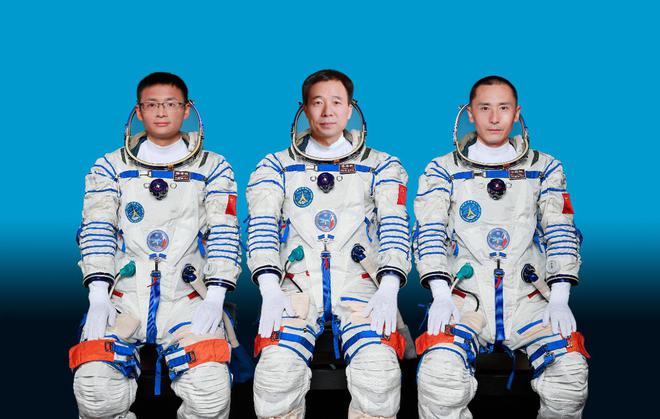Shenzhou 16 Successfully Expedited to Musk: China Aerospace Super Bull!
Wen | Yu LiuProduced by NetEase Technology's "Dream Chasing Starry Sky" program groupToday, the Shenzhou 16 manned spacecraft was launched from the "Long March 2F" Yao 16 carrier rocket in Jiuquan. After the separation of the ship and arrow, the spacecraft will adopt a fast rendezvous and docking mode for ascent, and finally dock at the radial port of the "Tianhe" core module
Wen | Yu Liu
Produced by NetEase Technology's "Dream Chasing Starry Sky" program group

Today, the Shenzhou 16 manned spacecraft was launched from the "Long March 2F" Yao 16 carrier rocket in Jiuquan. After the separation of the ship and arrow, the spacecraft will adopt a fast rendezvous and docking mode for ascent, and finally dock at the radial port of the "Tianhe" core module.
The Shenzhou-10 manned spacecraft is the first launch of China's space station engineering application and development stage, and also the 11th manned launch of China's manned space program; It is the first flight mission of the third batch of astronauts, and also the first flight mission of aerospace Flight Engineer and payload experts.
Just a few hours ago, Tesla and SpaceX CEO Musk released a statement on social media regarding China's 2030 manned lunar landing plan, stating, 'China's space program is more advanced than most people realize.'

Shen16: New batch of spacecraft launches
Shipbuilding is for building stations, and building stations is for application. This is the original intention of the development of China's manned space engineering construction. In 2023, the Chinese space station officially entered a 10-year application and development phase, and according to the mission plan, Chinese astronauts will be on regular duty. This year, after the Shenzhou 16 manned spacecraft, there will be one launch of the Shenzhou 17 manned spacecraft and two return missions.
It is reported that after the "Shenzhou 16" spacecraft is in place, the space station will form the main three modules as the skeleton. The "Shenzhou 15", "Shenzhou 16", and "Tianzhou 6" cargo spacecraft will respectively dock with the six module (ship) assembly at the forward, radial, and backward ports of the "Tianhe" core module. This is the 24th configuration since the establishment of the space station, and the configuration composition is similar to the on-orbit handover phase of "Shen14" and "Shen15", The mass of the combination in orbit will exceed 100 tons.
In 2022, China completed the "three step" strategic task of manned space engineering and completed the construction of China's space station.

"It is of great significance to build a space station in China. There are two main tasks of the space station. One is to conduct space science and technology experiments in low Earth orbit of about 400 kilometers, and the other is to lay a firm foundation for future human exploration of the moon, especially Mars." Huang Zhicheng, an aerospace expert, told NetEase Technology.
He continued to explain that people are increasingly aware of the significance of the second meaning. The space station will become the infrastructure for humans to advance into deep space, as it takes at least six months for humans to land on Mars and endure strong space radiation during this process, which has a significant impact on the human body. The space station can provide basic research work for humans in space, especially their health.
On the other hand, in order for humans to build bases on the moon, they must solve a series of tasks such as equipment, manufacturing, and maintenance. Therefore, in recent years, people have realized that an important task of the space station is to provide necessary technical preparations for human exploration of deep space. "Huang Zhicheng believes.
It is understood that the application and development phase of the Chinese space station over the past decade will utilize the scientific experimental cabinets and large payload facilities arranged inside the space station cabin to carry out larger scale space research experiments and new technology experiments.
This mission is the first of a new batch of spacecraft from the "Shenzhou" spacecraft, and the Shenzhou 16 spacecraft has undergone multiple upgrades on the basis of the Shenzhou 15 spacecraft. Firstly, domestic substitution, especially the replacement of core components, greatly enhances the spacecraft's autonomous and controllable ability; Secondly, the human-computer interaction interface is more user-friendly, making it easier and faster for astronauts to operate.
Hao Chunzeng, Director of the China Manned Space Engineering Office, stated that in order to further enhance the comprehensive capabilities and technological level of the project, China will also develop a new generation of manned launch vehicles and spacecraft. Among them, the return modules of the new generation of manned launch vehicles and spacecraft can be reused. The comprehensive capacity of the new generation of manned spacecraft has also been significantly improved, capable of carrying 7 astronauts. In addition, its uplink and downlink payload capacity has also been significantly improved. At the same time, we are considering developing an expansion module for the space station to further support in orbit scientific experiments and create better conditions for the work and life of astronauts.
The Chinese space station has entered a stage of application and development, with the implementation of crew rotation and cargo supply tasks on a regular basis. The on-orbit work arrangement of astronaut crew has also tended to be normalized.
The first payload expert to enter space
The biggest surprise of the crew of the "Shenzhou 16" mission is that the first load expert enters space to carry out the mission: the Shenzhou 16 crew is composed of one of the first batch of astronauts and two of the third batch of astronauts. Among them, the space pilot Jing Haipeng and the space Flight Engineer Zhu Yangzhu are from the crew of astronauts, who are mainly responsible for the direct manipulation and management of spacecraft, as well as carrying out relevant technical tests; Load expert Gui Haichao is a professor at Beijing University of Aeronautics and Astronautics, mainly responsible for the in orbit operation of space science experimental loads, and has received professional training in fields such as science and aerospace engineering.

Netizens joked that "wearing glasses can also go into space".
So, what kind of payload expert? What is load first? The instruments, equipment, personnel, experimental organisms, and specimens loaded on a spacecraft that directly carry out the spacecraft's in orbit operation tasks are called payloads. Load experts are selected from researchers in the field of manned space engineering, space science research and application, and are mainly responsible for the in orbit operation of space science experimental loads.
Lin Xiqiang, Deputy Director of the China Manned Space Engineering Office and spokesperson for the engineering news, introduced the two third batch of astronauts who were on their first mission. On the basis of joint training with the crew, they further improved their operational and adaptive abilities by strengthening key subject training, making comprehensive preparations for the mission.
It is understood that before taking the flight, Guihai Tide underwent strict training and assessment in 8 categories and over 200 subjects.
Previously, the China Manned Space Engineering Office announced that a total of 18 (including one female) of the third batch of preparatory astronauts for China's manned space program were finally selected, including 7 space pilots, 7 aerospace Flight Engineer and 4 payload experts, who will become new members of China's astronaut team. In order to meet the needs of China's space station engineering mission, the third batch of preparatory astronauts added two categories of aerospace Flight Engineer and payload expert on the basis of space pilots.
It is reported that the selection of China's fourth batch of preparatory astronauts has been launched in 2022. According to the plan, 12 to 14 preparatory astronauts will be selected, including space pilots, space Flight Engineer and load experts, and load experts will be selected in Hong Kong and Macao for the first time. As of March 2023, the preliminary selection stage has been completed.
References:
Beijing Daily: "Divine Sixteen Astronauts Appear with 2 'Newcomers'"
Honor! Divine Sixteen Astronauts, First Load Expert, Beihang Guihai Tide
China's manned space program "Official | Shenzhou 16 Manned Flight Mission Press Conference Held"
China will develop a new generation of manned spacecraft, capable of carrying 7 people
Military Military Secondary Plane "Divine Arrows Out of Sheath, Waiting for Flying Sky | Three Highlights of" Divine Sixteen "
Tag: Shenzhou Successfully Expedited to Musk China Aerospace Super Bull
Disclaimer: The content of this article is sourced from the internet. The copyright of the text, images, and other materials belongs to the original author. The platform reprints the materials for the purpose of conveying more information. The content of the article is for reference and learning only, and should not be used for commercial purposes. If it infringes on your legitimate rights and interests, please contact us promptly and we will handle it as soon as possible! We respect copyright and are committed to protecting it. Thank you for sharing.


